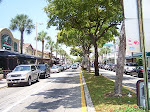 Vesuvius less than 10 miles north of town erupted, sending hot gas, mud and lava towards the doomed city. When the ash cloud first appeared, residents too to the streets with the valuable they
Vesuvius less than 10 miles north of town erupted, sending hot gas, mud and lava towards the doomed city. When the ash cloud first appeared, residents too to the streets with the valuable they  could travel. Thinking the beach would be a safe haven, many awaited their fate. The only known survivor was Pliny the Younger, who took to sea, escaping the nearly 900 degree gas cloud. Death came quick to the mountain's victim.
could travel. Thinking the beach would be a safe haven, many awaited their fate. The only known survivor was Pliny the Younger, who took to sea, escaping the nearly 900 degree gas cloud. Death came quick to the mountain's victim.When the eruption finally ended, the lavish villas of Pompeii and Herculaneum were buried
 under almost 10 feet of ash and lava. Their secret remained hidden for almost 1700 years. Excavations began around 1748 and continue today. The city was a retreat for Rome's wealthy. Villas were heated with warm air passing through cavities it walls and floors. Water was brought to the city with aqueducts to provide a drinking source and provide for sanitation. Frescoes covered walls and mosaics decorated the floors, sculpture adorned courtyard gardens.
under almost 10 feet of ash and lava. Their secret remained hidden for almost 1700 years. Excavations began around 1748 and continue today. The city was a retreat for Rome's wealthy. Villas were heated with warm air passing through cavities it walls and floors. Water was brought to the city with aqueducts to provide a drinking source and provide for sanitation. Frescoes covered walls and mosaics decorated the floors, sculpture adorned courtyard gardens.Since most of the destruction came a result of the ash cloud's collapse, the majority of the damage was to the roofs giving way under the weight.
With the excavations, the upright walls, columns and remains of daily life were uncovered.
 Tracks for sliding doors on markets were uncovered, the remains of the water system revealed themselves, grand villas that occupied entire blocks saw sunlight after almost 2 millennium. A few of the structures have been restored to their pre-eruption state. One a small villa, the other, one of the brothels. Modern man seems as obsessed with sex as much as the ancient Romans. On the tour, the
Tracks for sliding doors on markets were uncovered, the remains of the water system revealed themselves, grand villas that occupied entire blocks saw sunlight after almost 2 millennium. A few of the structures have been restored to their pre-eruption state. One a small villa, the other, one of the brothels. Modern man seems as obsessed with sex as much as the ancient Romans. On the tour, the  brothel definitely had a longer line to get in that the villa.
brothel definitely had a longer line to get in that the villa.The streets were also part of the sewer system, water flowed continuously down the gutters. To keep the population from having to step in the dirty effluent, large stones were placed for stepping stones. The stones were spaced to allow animal pulled carts to pass, necessitating a standard axle length. The groves from so many whens passing between the stones is evident by the grooves worn between the blocks.
 Street signs were not as we know them today. They consisted of various mosaic shapes placed at corners. Geometric sunburst of various colors and number of rays, defined the street's identity.
Street signs were not as we know them today. They consisted of various mosaic shapes placed at corners. Geometric sunburst of various colors and number of rays, defined the street's identity.Damron Vacations can help in planning your exploration of the ancient world frozen in time. The Naples/Pompeii area is an easy drive or train ride from Rome for a day trip. Or stay on the dramatic Amalfi Coast and visit the Isle of Capri with its famed Blue Grotto too.





No comments:
Post a Comment